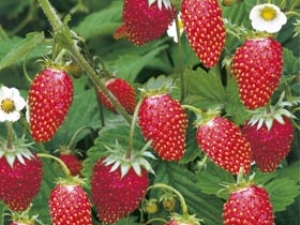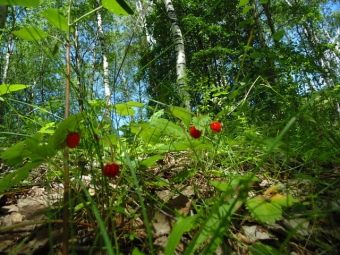Forest strawberries and strawberries: features and differences

Strawberry (lat. Fragaria, translated as “fragrant”) is a genus of perennial herbaceous plants of the Rosaceae family.The name given to this genus was given to the Swedish natural scientist Karl Linnaeus. More than 20 species of berry plants are included in the presented genus. Let's get acquainted with the most common wild plants from this botanical classification.
Characteristics of the strawberry family
Forest strawberries (Fragaria vesca) grow in many European countries, throughout the territory of Siberian taiga, on the slopes of the Caucasus Mountains, in forest and forest-steppe zones of Central Asia, throughout the European part of the Russian Federation. The plant lives on sunlit glades and forest edges, in steppes, in deforestation areas, on hillsides, near forest roads, among thickets of bushes.
The maximum height of the plant is 20 cm. The strawberry forest has a small rhizome, with many fine adventitious small roots. Elevated shoots (whiskers) are long, creeping, they take root in the nodes, due to them the reproduction of plants is carried out. The leaves are alternate, growing from the basal sinuses, are on long petioles, large, in shape, toothed. The top of the sheet is light green, smooth, the bottom of the sheet is green with a grayish tint and edge.
Plants in diameter are 1-1.5 cm, are on long pedicels and are collected in inflorescences, they are bisexual. Flowers are quite large in white. The berries are small, having a rounded, slightly oval or conical shape. The color of ripe berries can be from bright red to almost white. The berries are very juicy with a pleasant taste and aroma. The plant begins to bloom in late May, early June, bears fruit from the second decade of June until the end of July. Strawberry high yielding.
Green strawberries (it is also called half-melon) (Fragaria viridis) is located on forest edges and meadows. Strawberries grow in Europe and Asia (in areas with a predominantly temperate climate). The plant has a height of not more than 25 cm, the leaves are dark green in color, bisexual flowers, the diameter of which does not exceed 2.4 cm. During the vegetative period small, very short knotless mustaches grow. The size of the fruit is similar to wild strawberry berries. The shape of the berries can be both round and ovoid. The color of the berries is dominated by pink, found bright red or yellowish-white with a red top of the fruit.
Muscat strawberries - popularly known as forest strawberries - grows throughout the European part of the Russian Federation and the vast part of Siberia. Strawberries grow in juniper thickets, in pine forests, on mountain slopes, on forest edges, it can be found near an embankment along roads. The plant has a thin stem, whose height is from 5 to 18 cm, an underdeveloped rhizome, very short creeping shoots (whiskers).
The leaves are trifoliate, are on short petioles, the bottom of the sheet has a silky edge to the touch. Flowers are mostly white, but sometimes there are plants with pinkish flowers. Small strawberry berries with a spherical shape. The color of the fruit is mainly light pink (sometimes it is found gently yellow), which gradually turns into the red top of the berry. The fruits have a very pleasant smell. The plant begins to bloom in late May, the harvest is produced in late July and August.
Kinds
Different types of strawberries are similar in appearance, their main differences are:
- the size of the flowers and the size of the berries;
- the appearance of the berries in shape and color;
- the difference in shape, relief and color of the sheet;
- arrangement of antennae to the central stalk;
- the shape of the stem and the ability to separate it from the berries;
- different yields;
- various tastes and aromas of berries.
Externally, the flowers of all plants of the pink family look similar - they are almost all white and have five petals. The main difference between different types of strawberries is that the plants have flowers:
- same-sex and dioecious, that is, there are female and male plants;
- monoecious and self-pollinating.
On male bushes of same-sex plants only flowers have stamens, and on female bushes there are pistils on flowers.In order to form a berry, it is necessary that insects carry out pollination. In the spring, forest strawberries are very abundant and beautifully blooming, but without pollination, you can generally remain without a crop. The consequence of the heterogeneity of plants is that very few fruits are tied up.
Wild and meadow berries
Wild forest strawberries grow in the forest under the shade of trees, and in meadows where the abundance of the sun grows, its meadow variety grows. Meadow strawberries and meadow strawberries are different types of plants that differ among themselves in many ways. The berries of the meadow strawberries are similar in taste and appearance to the berries of the garden strawberries, the flesh is very tender, much softer than the meadow strawberries, such a berry can be harvested without a stem. In turn, the taste of meadow strawberries is significantly different from the garden. Its fruits are much smaller and have their own unique bright aroma.
The stem of the strawberry is very tightly attached to the berry, so without it the berry is not harvested.
Taste qualities
The taste of strawberries is almost impossible to recognize. The aroma of wild strawberries has notes of musk and honey, experienced foresters call this aroma “the smell of the forest”, it is no coincidence that strawberries have a name - fragaria moschata (Latin), which means “muscat”.
The taste of different types of strawberries is very different:
- not even ripened wild strawberry has a pronounced sweet taste, but wild strawberries are always sour, therefore its taste is associated with notes of taste of kiwi fruit;
- the flesh of the forest strawberry may have a pink or red color; its relative has only white;
- The peculiarity of wild strawberry is that its berries have hard seeds.
Growing up
Agrotechnika wild strawberries in the garden plots has no difficulties. The plant is unpretentious, and even when planted in places where there is a slight darkening, it grows very well and bears fruit. Planting can be carried out both in autumn and in spring. Planting material are whiskers. Planting is best done in rows, following the scheme: between rows should be a distance of 60-70 cm, and between bushes 20 cm. In order to get a harvest from dioecious plants, it is necessary to plant different-sex plants.
It should be noted that male bushes show their aggressive nature and grow wildly, thus, they are replacing instances with female flowers from year to year.
There is the problem of pollination - because of what the ovary does not appear on all plants. If garden strawberries grow in a garden plot, then forest strawberries should not be planted next to them, because they can pereopilyatsya, as a result you can get new plants that will practically be weeds, unable to bring high-quality crops.
How to prepare wild strawberries for the winter, you will learn from the following video.



























